
Case Studies for Advances in Paleoimaging and Other Non-Clinical Applications
3 authors - Hardback
£86.99
Ronald G. Beckett is Professor Emeritus in the Department of Biomedical Sciences at Quinnipiac University. Beckett began his career as a respiratory therapist and became a supervisor at Tucson General Hospital in Tucson, Arizona, in 1977. While there he was an instructor for the Pima Community College's program in respiratory care. Beckett moved to Rhode Island in 1983 where he established the first college-based program in Respiratory Care in the state at the Community College of Rhode Island. Not long after the program was accredited, Beckett moved to Hamden, Connecticut, where he became director of the bachelors degree program in Respiratory Care at Quinnipiac University. He soon became Chairman of the department of Cardiopulmonary Sciences and Diagnostic Imaging, a position he held for 23 years. Following a conversation with co-author Conlogue regarding mummy research, Beckett realized the endoscopic imaging potential in bioanthropological settings. He began conducting experiments using the combination of radiography and endsocopy in the laboratory setting. Finding that the techniques were complementary, Beckett began to work with Conlogue on projects involving the paleoimaging of mummified remains in 1996. Following the initial work in the Cardiopulmonary Sciences laboratory, Beckett began to apply endoscopy in concert with radiography on the Max Uhle collection of mummies from Pachacamac Peru at the University of Pennsylvania in Philadelphia, Pennsylvania. Techniques were further developed through paleoimaging projects involving mummified remains at the Yale Peabody Museum of Natural History in New Haven, Connecticut. Beckett continued to refine and develop new field techniques and skills in bioanthropological data collection using endoscopic instrumentation. In 1999, Beckett and Gerald Conlogue co-founded the Bioanthropology Research Institute at Quinnipiac University. Beckett's work with mummified remains has been featured in many television documentaries regarding paleoimaging on the Discovery and Learning Channels. Beckett and Conlogue's field paleoimaging work, caught the interest of the National Geographic Channel and they served as co-hosts for a three year, 40 episode documentary series called "The Mummy Road Show". Their work with National Geographic took them to over 13 countries conducting paleoimaging research on mummified remains and artifacts. In 2005, they published "Mummy Dearest", a behind the scenes look and in depth account of their experiences producing the series. In the fall of 2009 CRC Press has published their second book, "Paleoimaging, Field Applications for Cultural Remains and Artifacts". Beckett continues to be an invited speaker at many universities as well as at domestic and international scientific symposia. He continues to conduct paleoimaging research and gives public presentations for museums and civic organizations. Gerald Conlogue is Co-Director of the Bioanthropology Research Institute at Quinnipiac College. In 1999, Beckett and Gerald Conlogue co-founded the Bioanthropology Research Institute at Quinnipiac University. He hold a BS in Animal Sciences from the University of Connecticut and a Master’s of Health Science from Quinnipiac College. He has worked as a professors since 1984 and has taught and worked at Quinnipiac College since 1992. Conlogue began to work with Ronald Beckett on projects involving the paleoimaging of mummified remains in 1996. Their work with National Geographic took them to over 13 countries conducting paleoimaging research on mummified remains and artifacts. In 2005, they published "Mummy Dearest", a behind the scenes look and in depth account of their experiences producing the series. In the fall of 2009 CRC Press has published their second book, "Paleoimaging, Field Applications for Cultural Remains and Artifacts". Conlogue continues to be an invited speaker at many universities as well as at domestic and international scientific symposia. He continues to conduct paleoimaging research and gives public presentations for museums and civic organizations.